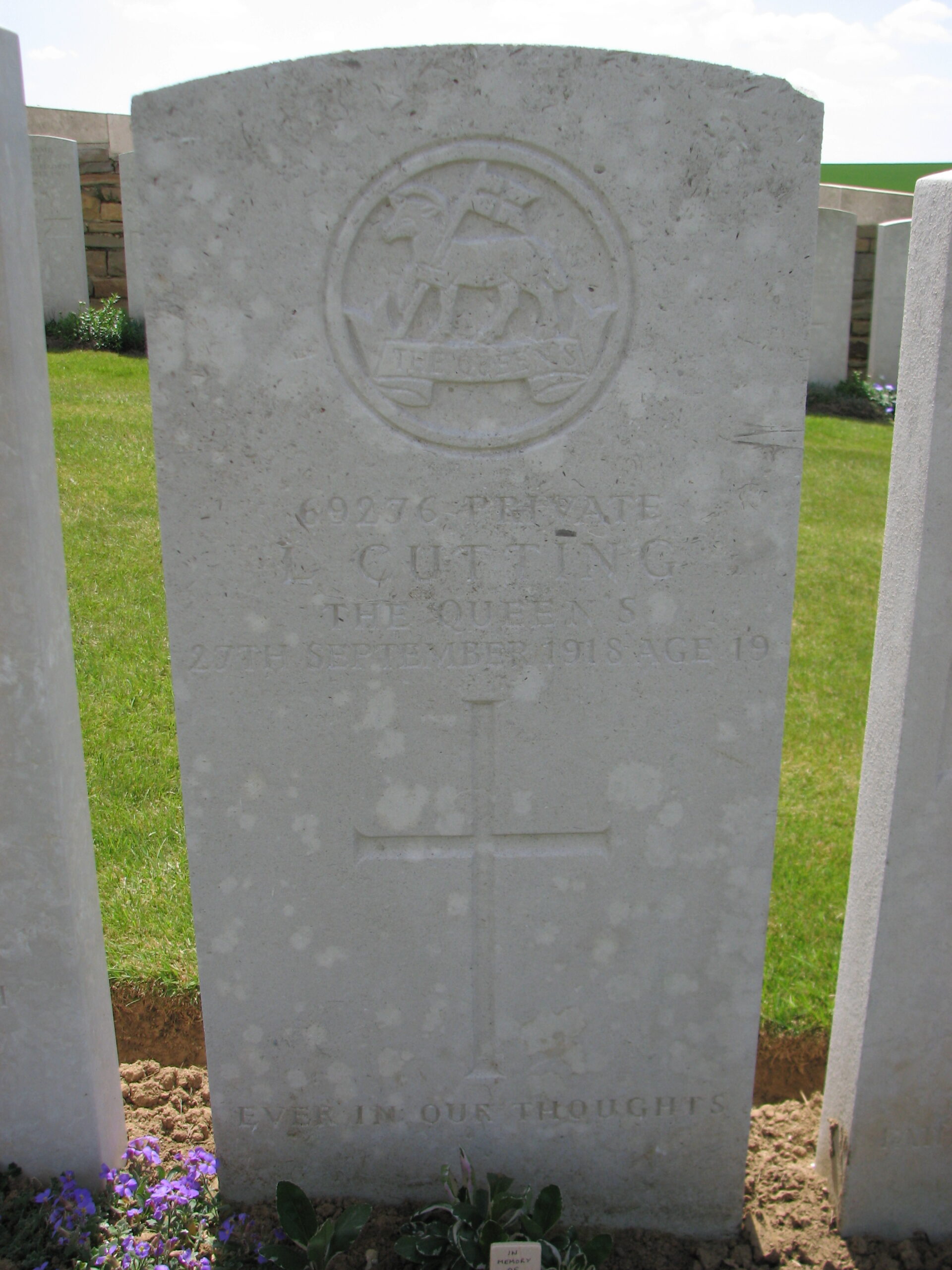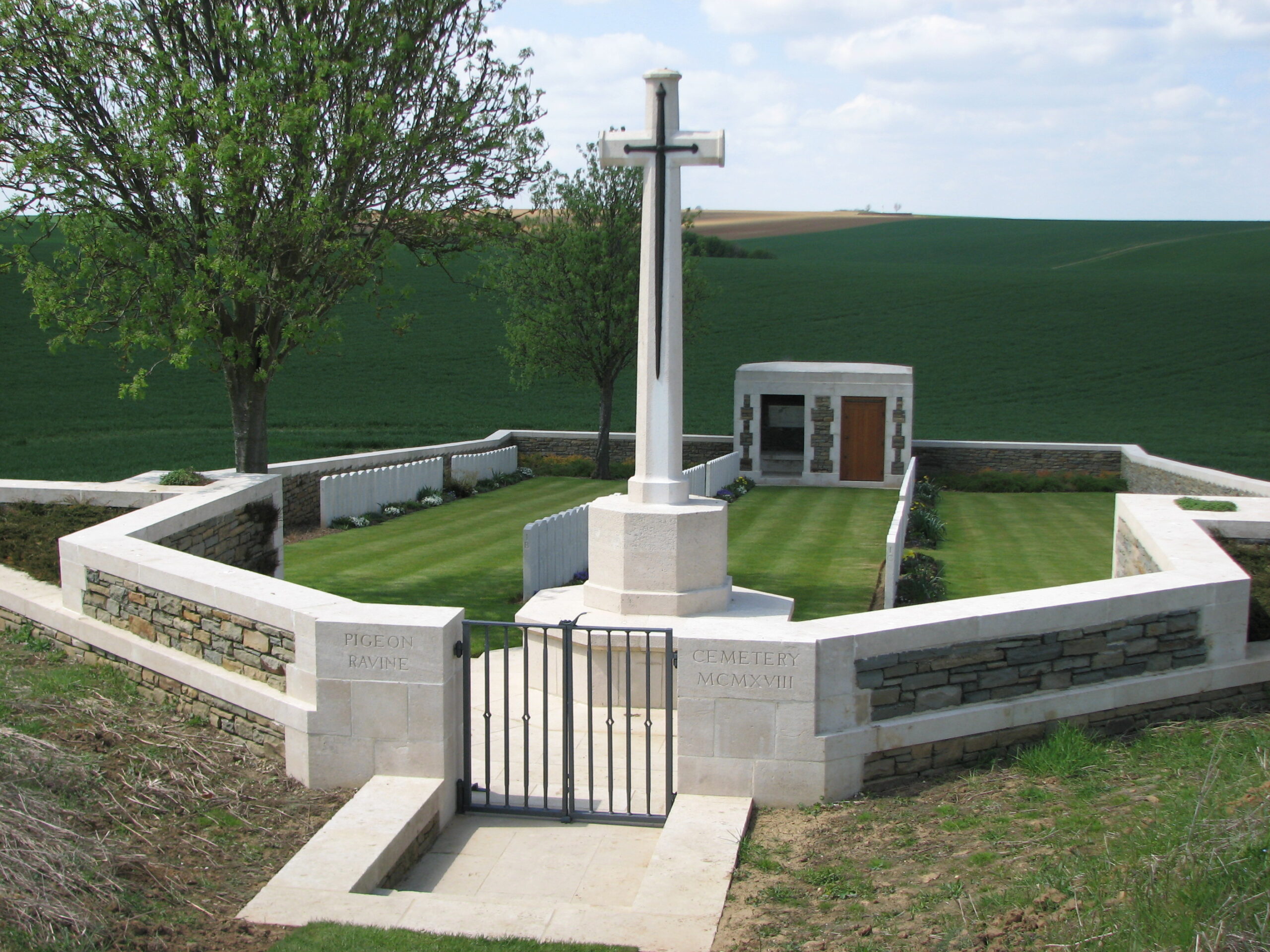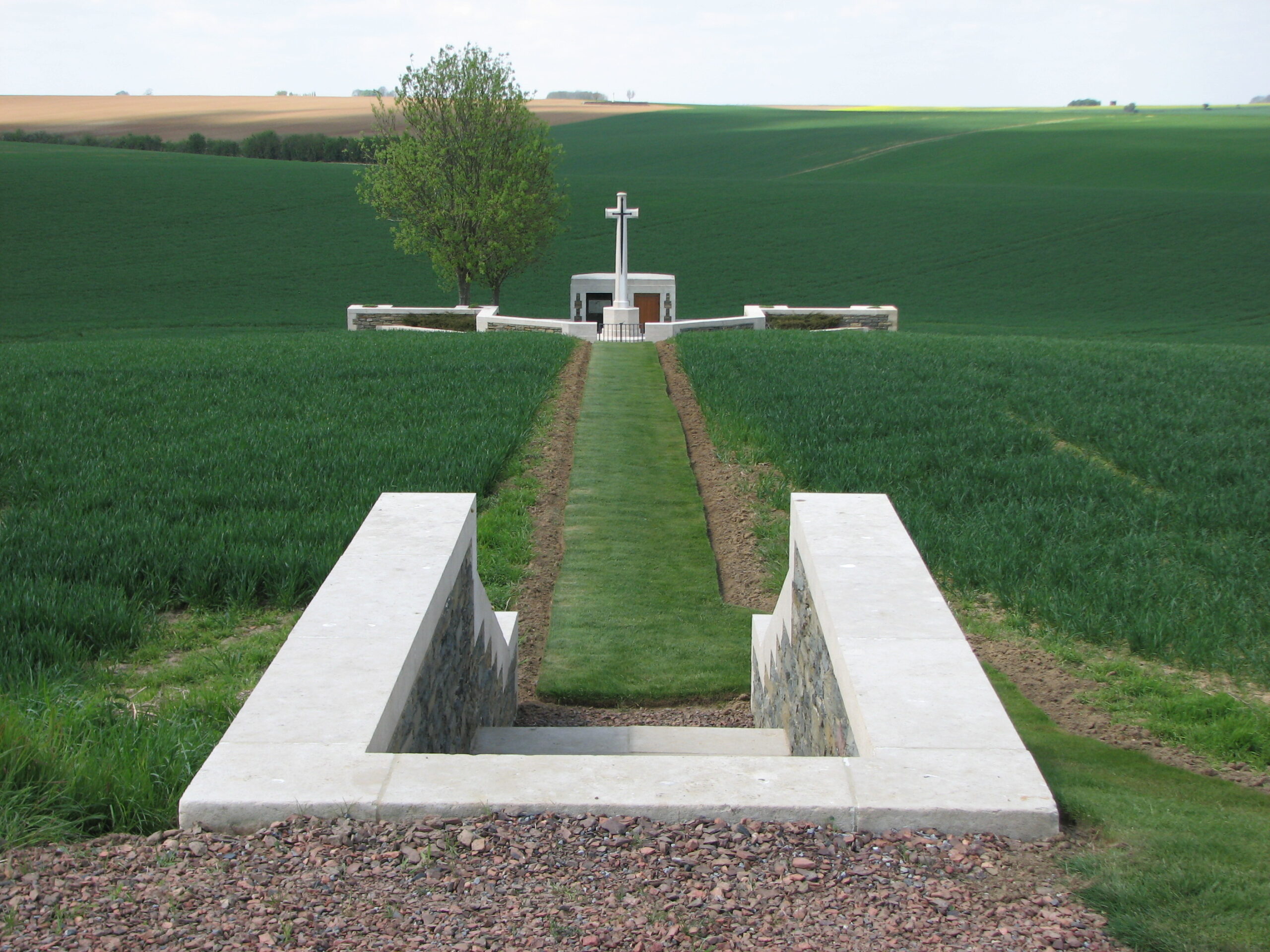Leslie Cutting (1899 - 1918)
Leslie is one of six 19 year olds who are commemorated on the Village Memorial to Those Who Died in the Great War. He was was killed in action on the Western Front, less than two months before the Armistice was signed.
- 28
- Died in the Great War
- 51.972703, 1.060141
Details
| Name: | Leslie Cutting |
| Service: | British Army |
| Unit: | 6th Battalion, The Queen’s (Royal West Surrey Regiment) |
| Regimental Number: | 69276 |
| Rank: | Private |
| Date of Death: | 27th September 1918 |
| Age: | 19 |
| Buried: | Plot II, Row B, Grave 13, Pigeon Ravine Cemetery, Near Epehy, France. |
Family Background and Early Life
Leslie Cutting was born at Cattawade on 13th February 1899, the youngest of 10 children from the marriage of George William Cutting and his wife Esther.
George Cutting was originally from Hadleigh in Suffolk, and had married Esther Thorpe from Wattisham in 1874. They spent the first decade of their marriage in London, before returning to their native Suffolk in the late 1880’s.
In Suffolk, they lived initially in Raydon for several years, before moving to Brantham in the mid 1890’s. In 1904, the Cuttings moved to East Bergholt where they initially lived in Howe Cottage and later in Myrtle Cottage at East End.
George had worked as an Ostler whilst the family were in London, but after they moved to Suffolk he was employed as a Journeyman Miller, and later as a Farm Labourer.
Leslie left school in 1912. Unfortunately, there appears to be no surviving records detailing what he did next by way of employment.
Conscription
The Great War had been raging for two and an half years when Leslie reached his 18th birthday, and very shortly afterwards he was conscripted into the British Army. With a small number of exceptions, since early 1916 the armed forces no longer accepted volunteers and every new recruit was conscripted.
Upon completion of an initial period of training, Leslie was posted to the 3rd Battalion of the Royal Sussex Regiment in October 1917, then based at Newhaven in Sussex.
France
Until April of 1918, a soldier was not permitted to be sent overseas until he was 19 years of age. We do not know exactly when in the spring of 1918 Leslie was sent to France, but it seems most likely to have been in early April when he was probably posted to the Royal Sussex Regiment’s 11th Battalion.
The Battalion had been severely mauled in the German offensive of March 1918. By this stage of the War, the British were suffering from a severe shortage of manpower, and so in late May most of the men remaining with the 11th Sussex were transferred, and the Battalion reduced to a training cadre.
Many of the men who had been in the 11th were transferred to an Infantry Base Depot. On 6th July, Leslie and a group of those who had been in the 11th Sussex were transferred to the 6th Battalion of The Queen’s (Royal West Surrey Regiment), actually joining it 3 days later.
The 6th had been in France since 1915, serving as part of the 12th (Eastern) Division. Like most battalions that had been in France for 3 years, the majority of the men serving with them in 1918 were replacements.
At the time that Leslie joined the 6th, they were just coming out of the line and for the best part of a month would be engaged in reorganisation and training.
In the spring of 1918, the Germans had launched a series of offensives directed primarily against the British. They were intended to knock the British out of the war, and cause the French to sue for peace before increasing numbers of United States troops arrived on the Western Front.
The British losses in both men and territory caused a crisis, but with French assistance the front was stabilised.
The German offensives had effectively signalled the end of the stalemate of trench warfare that had existed on the Western Front since late 1914. However, the offensives had also seriously depleted the manpower and material reserves of the German Army, and as a result of their large territorial gains they now occupied temporary defences, rather than established formidable ones like the Hindenburg Line.
Marshal Foch (the newly appointed Allied Supreme Commander) and the commander of the British Expeditionary Force Field Marshal Haig, now decided the time was ripe for the Allies to go over to the offensive.
“The Hundred Days”
On 4th August 1918, Leslie and the 6th Queen’s went into the line. Four days later the British launched a limited – though extremely successful – offensive. The 12th (Eastern) Division only played a holding role, but they did achieve their objectives and advanced 2 miles.
History now sees this as marking the start of what is called “The Hundred Days”, a series of victories for the Allies which culminated in the Germans suing for peace and signing of the Armistice on 11th November.
In late August, the Battalion took part in a second offensive, which successfully recaptured the old 1916 Somme battlefield. By 19th September, the 6th Queen’s were positioned near the village of Epehy, south of Cambrai. Since 8th August they had advanced nearly 20 miles (a feat that would have been unheard of earlier in the War) and for the next two days, they were involved in successful attacks to the east of Epehy.
On the 26th September, the Battalion had been tasked to attack a German position to the east of Epehy called Dados Loop. The Battalion’s War Diary written on that day recounts:
“Bn attacked DADOS LOOP at dawn; objective gained but we were forced to withdraw by counter-attack. Attack was attempted once more with same result. No further effort was made and the Bn was withdrawn at night, and rejoined 37 Inf. Bde in Div Reserve.” 1 Taken from the War Diary of 6th Battalion, The Queen’s (Royal West Surrey Regiment) for September 1918 (National Archives WO 95/ 1863).
Official records state that Leslie was killed in action on 27th September 1918. Whilst we cannot say for certain that he was not killed on that date, there is a very good chance that he actually lost his life in the fighting on the 26th. 2 Commonwealth War Graves Commission records state that the 6th Battalion of The Queen’s (Royal West Surrey Regiment) suffered no dead on 26th September – an extremely rare occurrence if they had been forced to withdraw from their objective because of a German counter-attack. However, the same records state that the Battalion lost 7 men (including 5 who have no known grave) on the 27th, at a time when they were in Divisional Reserve until midnight.
Unless the man’s death was actually witnessed, then it was not uncommon for a soldier’s date of death to be recorded as being on the date when the first Roll Call was taken after the Battalion came out of the line. The location of Leslie’s grave also supports the theory that he was killed on 26th September.
Leslie was buried in Pigeon Ravine Cemetery, close to where he fell. 3 For many years, Leslie’s surname was recorded in some of the Commonwealth War Graves Commission’s records as Cuttings. This error has now been corrected. He rests there still.
Copyright © Mark Ashmore, 2024
- 28
- Died in the Great War
- 51.972703, 1.060141




